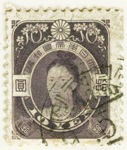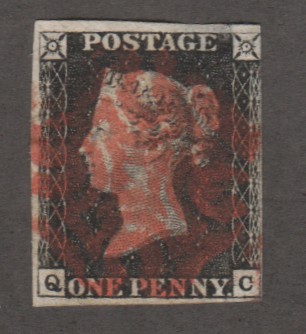
Discussion - Member to Member Sales - Research Center

Discussion - Member to Member Sales - Research Center

Single stamps from booklets are identified by a dot in the centre of the top and bottom margin of each stamp. These dots are occasionally removed by the perforations. Booklets were first issued in July 1930, and contained three panes of 4 3d stamps plus a pane of airmail etiquettes. A new cover design appeared in May 1935.
In the ACSC it mentions that in each pane there are 2 of the variety long wing aeroplane, this is incorrect as there is one variety per pane. Only in Type B will this variety be found.
The ex-booklet stamps and photograph is from the Arthur Gray collection, one of my finer acquisitions.
The image is the original official 1930 publicity photograph with Department of the Interior News & Information Bureau cachet on reverse, and file no. L16788.



Department of the Interior News & Information Bureau

Type A

Type B


Left - Type A showing dot. Right - Type B showing dot

7 Members
like this post.
Login to Like.
Hi Rob,
Thanks for the interesting post and clear pictures.
I've never looked as this stamp before and didn't know about these dots.
"In the ACSC it mentions that in each pane there are 2 of the variety long wing aeroplane, this is incorrect as there is one variety per pane. Only in Type B will this variety be found."
I have a 2001 ASCS and I read this to be saying:
136d Long wing to plane - stamp #2 in the type A pane.
136f Vertical hairline through stamps - stamps #1, #3 and #4 in the the type A pane.
where type A has the vertical mesh paper and type B has the horizontal mesh paper.

1 Member
likes this post.
Login to Like.
Excellent information!
Also, the DH66 de Havilland biplane flying over pastoral scene is amazing. By putting all the text at the top, flying with the plane, the design allows for an unencumbered meadow, river, and sheep. Any stamp with sheep on it is a bonus.
This is one of my favorite designs, if not my favorite. (US -Cattle in Storm is hard to top).
According to my ACSC the stamp was designed by Harold Herbert and Ronald Harrison. Engraved by Arthur Taylor.
Thanks for posting Rob.
Wine

Login to Like
this post
Hi nigelc
I’m glad my post sparked a renewed interest in the 1929 airmail stamp. Yes it does mention that 136d can be found in the Type A booklet pane, I was told from an expert who specialises in pre-decimal Australian stamps that the information relating to Type A and the long wing variety id incorrect and that the variety can only be found in the Type B booklet only and only one variety in a pane, not 2.
Hopefully when the next KGV catalogue is released the incorrect information will be amended. I am quite interested in 136f and will today (hopefully) will found more information for my next input.
Rob

Login to Like
this post
Hi Wine
Thanks, I’m glad you found the information interesting. The designers put a lot of thought into that stamp, considering it was to become Australia’s first official airmail stamp. The KGV and KGVI commemoratives were in a league of their own.
And you are correct about the designers and engraver.
Rob

Login to Like
this post
Great info Rob.
Is the booklet dot an artifact in all Aussie booklet stamps or just this particular issue?
Regardless, it creates an idea of something else to search for...
Dave

Login to Like
this post
Hi lemaven
It is only in this particular stamp, they are scarce but not impossible to find one hidden in a collection. Most of those that have been used are hidden by the cancellation or been removed through the perforation process.
I have though made a mistake in my earlier story about these stamps, I mentioned that the ACSC (Australian Commonwealth Specialists' Catalogue) mentioned it to be in Type A and that the correct booklet was Type B.
The ACSC version was actually correct, and the very scarce variety can only be found in a small quantity of Type A booklets.
The only error the ACSC made concerning these booklet stamps is in the variety, it mentions that there are two to a pane, this is incorrect, as only one variety is found in a minority of the Type A pane.
Rob

Login to Like
this post
Member ACCC (Australian Commonwealth Collectors Club of NSW)
05 Dec 2017
03:01:27am
Booklet Stamps
Single stamps from booklets are identified by a dot in the centre of the top and bottom margin of each stamp. These dots are occasionally removed by the perforations. Booklets were first issued in July 1930, and contained three panes of 4 3d stamps plus a pane of airmail etiquettes. A new cover design appeared in May 1935.
In the ACSC it mentions that in each pane there are 2 of the variety long wing aeroplane, this is incorrect as there is one variety per pane. Only in Type B will this variety be found.
The ex-booklet stamps and photograph is from the Arthur Gray collection, one of my finer acquisitions.
The image is the original official 1930 publicity photograph with Department of the Interior News & Information Bureau cachet on reverse, and file no. L16788.



Department of the Interior News & Information Bureau

Type A

Type B


Left - Type A showing dot. Right - Type B showing dot

7 Members
like this post.
Login to Like.

re: 1930 ex-booklet airmail stamps with dot (ex-Arthur Gray collection)
Hi Rob,
Thanks for the interesting post and clear pictures.
I've never looked as this stamp before and didn't know about these dots.
"In the ACSC it mentions that in each pane there are 2 of the variety long wing aeroplane, this is incorrect as there is one variety per pane. Only in Type B will this variety be found."
I have a 2001 ASCS and I read this to be saying:
136d Long wing to plane - stamp #2 in the type A pane.
136f Vertical hairline through stamps - stamps #1, #3 and #4 in the the type A pane.
where type A has the vertical mesh paper and type B has the horizontal mesh paper.

1 Member
likes this post.
Login to Like.

re: 1930 ex-booklet airmail stamps with dot (ex-Arthur Gray collection)
Excellent information!
Also, the DH66 de Havilland biplane flying over pastoral scene is amazing. By putting all the text at the top, flying with the plane, the design allows for an unencumbered meadow, river, and sheep. Any stamp with sheep on it is a bonus.
This is one of my favorite designs, if not my favorite. (US -Cattle in Storm is hard to top).
According to my ACSC the stamp was designed by Harold Herbert and Ronald Harrison. Engraved by Arthur Taylor.
Thanks for posting Rob.
Wine

Login to Like
this post
Member ACCC (Australian Commonwealth Collectors Club of NSW)
05 Dec 2017
03:54:51pm
re: 1930 ex-booklet airmail stamps with dot (ex-Arthur Gray collection)
Hi nigelc
I’m glad my post sparked a renewed interest in the 1929 airmail stamp. Yes it does mention that 136d can be found in the Type A booklet pane, I was told from an expert who specialises in pre-decimal Australian stamps that the information relating to Type A and the long wing variety id incorrect and that the variety can only be found in the Type B booklet only and only one variety in a pane, not 2.
Hopefully when the next KGV catalogue is released the incorrect information will be amended. I am quite interested in 136f and will today (hopefully) will found more information for my next input.
Rob

Login to Like
this post
Member ACCC (Australian Commonwealth Collectors Club of NSW)
05 Dec 2017
04:31:40pm
re: 1930 ex-booklet airmail stamps with dot (ex-Arthur Gray collection)
Hi Wine
Thanks, I’m glad you found the information interesting. The designers put a lot of thought into that stamp, considering it was to become Australia’s first official airmail stamp. The KGV and KGVI commemoratives were in a league of their own.
And you are correct about the designers and engraver.
Rob

Login to Like
this post

re: 1930 ex-booklet airmail stamps with dot (ex-Arthur Gray collection)
Great info Rob.
Is the booklet dot an artifact in all Aussie booklet stamps or just this particular issue?
Regardless, it creates an idea of something else to search for...
Dave

Login to Like
this post
Member ACCC (Australian Commonwealth Collectors Club of NSW)
06 Dec 2017
05:27:21pm
re: 1930 ex-booklet airmail stamps with dot (ex-Arthur Gray collection)
Hi lemaven
It is only in this particular stamp, they are scarce but not impossible to find one hidden in a collection. Most of those that have been used are hidden by the cancellation or been removed through the perforation process.
I have though made a mistake in my earlier story about these stamps, I mentioned that the ACSC (Australian Commonwealth Specialists' Catalogue) mentioned it to be in Type A and that the correct booklet was Type B.
The ACSC version was actually correct, and the very scarce variety can only be found in a small quantity of Type A booklets.
The only error the ACSC made concerning these booklet stamps is in the variety, it mentions that there are two to a pane, this is incorrect, as only one variety is found in a minority of the Type A pane.
Rob

Login to Like
this post


